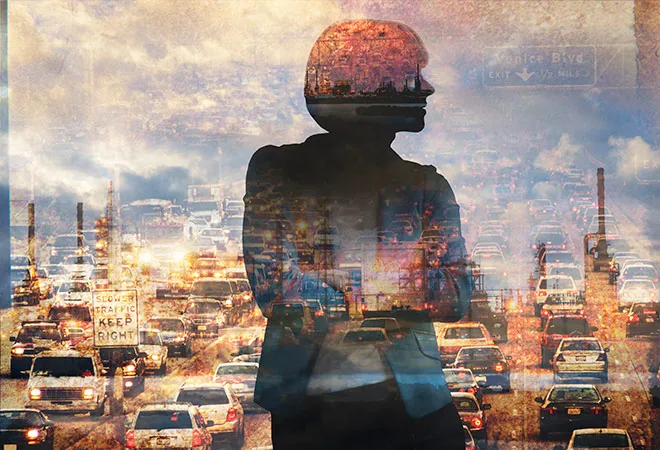
The recently concluded COP26 conference in Glasgow was a microcosm of how the global narrative around climate change is taking shape. There were many interesting developments—both happening in formal settings and on the streets. While the average age of the negotiators which were giving shape to climate pacts and pledges was around 60, there were people as old as 15, outside on streets carrying placards that read “We Need Action, Not Promises!”
To put it in perspective, a recent study led by the University of Bath found that 75 percent of young people surveyed believe the future is frightening because of climate change and 65 percent agreed with the statement that governments are failing young people. This is a dangerous paradigm, where people who will not be around to witness the impact of their decisions, are making promises, signing deals, and pledging money to save the lives of people who are protesting on the streets demanding action.
It is rather easy to wish away such voices of the youth, labelling them a result of youthful exuberance, or directionless angst, or even worse, a motivated propaganda. It is common that the governments either acknowledge the demands of the youth but only for lip service or paint the calls for immediate action, particularly by youth activists, as an extreme demand which fails to account for the maturity required to deal with the challenge in a balanced way.
This is a dangerous paradigm, where people who will not be around to witness the impact of their decisions, are making promises, signing deals, and pledging money to save the lives of people who are protesting on the streets demanding action.
There is a need to bust this myth that youthfulness and maturity are opposites. The statements, actions and practices undertaken by youth climate activists around the world are a testimony to the sheer maturity amidst the much-needed sense of urgency displayed by them. This also highlights as to how having youth take the driving seat for addressing climate change can actually drive sustainability by activating actions at scale. For instance, various technological interventions by youth are being lauded all over the world like the 15-year old Vinisha Umashankar for her invention of solar-powered iron.
Almost every climate warrior has argued and stressed on multiple occasions that climate change is not merely a crisis, it’s an opportunity that can deliver a win-win for everyone. This sentiment entails the spirit of taking everyone along and building a coalition towards a common threat, and capitalising on the opportunities of building back better.
The youth recognise the need for constructive dialogue but points to a very significant argument that such dialogues have not led us anywhere so far. This is as mature an approach as it can get. Consider the dialogues and deliberations that have gone into making our economies more inclusive, our laws more efficient, our state machinery more compassionate and people-friendly. The measure of development and change in public policy is welfare of the last person in the queue. On none of these indicators, it can be confidently construed that the most precarious of people have gained substantially and have an improved quality of life. There are reports, journalistic stories to the contrary, and just general observational anecdotes which prove that there’s a lot of ground yet to be covered.
Various technological interventions by youth are being lauded all over the world like the 15-year old Vinisha Umashankar for her invention of solar-powered iron.
Error in the system
This sentiment also points towards the fault lines in the way such dialogues have been structured and conducted so far. If it appears to the people being impacted by the decisions of such dialogues that not much action has happened on the ground so far, and perhaps the political leaders are not ‘walking the talk’, then there is something structurally wrong with the system of social dialogues. This goes true for climate deliberations as well. For instance, ‘building back better’ became a prominent rhetoric when it comes to political leaders’ stance on the intersection of climate change and the COVID pandemic. However, such rhetoric runs the risk of being mere sloganeering, falling short on account of any credible ground-level action, as many have pointed out in the climate change space. On the contrary, youth are indeed translating their talk into action. Be it the story of Green Hope Foundation which works in remote areas in Bangladesh to conserve mangroves and offer livelihood or food security solutions to the vulnerable population or the example of Nkosilathi Nyathi, 17, who is a UNICEF climate activist from Victoria Falls, Zimbabwe working on spreading awareness around the impact of climate change amongst young community members, there are concrete and visible actions being taken by climate activists. There is a United Nations Youth Advisory Group on Climate Change having voices from several countries, including a representative from India. They have also articulated their voices and credibly translating their vision into actions as demonstrated by their actions around the world. Such global advisory groups can also lead the way in showcasing the art of working together and working in response to a climate urgency, to various national governments.
There is a United Nations Youth Advisory Group on Climate Change having voices from several countries, including a representative from India.
Public welfare and employment
Youth have also been spot-on in acknowledging the impact of climate change on ‘jobs. Most country’s pledges and climate goals are centred around net-zero targets, reducing emissions, increasing renewable power generation, infusing climate-resilience in economic sectors, and other similar ambitions. Jobs, particularly green jobs, became an aftermath or some kind of an outcome of this green transition. This is similar to the problem of inclusive and equitable economic growth. Welfare of workers at the bottom of the pyramid has become an outcome of economic growth, and not an enabler. This secondary priority accorded to jobs, people’s welfare, and quality of life is a dangerous development which takes the narrative away from its core theme.
It is a significant attribute which is common around the messaging of GenZ of climate activists that it is not merely a very issue-specific conventional environmental campaign. This new age of environmentalism is also about overarching narratives climate justice and welfare of the most vulnerable group. This ought to make them the most mature group of people advocating for climate actions. Youth activists are campaigning and working towards climate adaptation, providing livelihood solutions, helping people cope with disasters and become more resilient ecologically and economically. And these are concrete actions, far away from the plans, policy documents, and guidelines that also limited countries have come out with for ‘just transitions’ in climate space.
Some youth activists have also shown their perspectives on the media and their role in climate actions. They have been one of the first set of stakeholders to point out that the attention of media has been on what the political leaders say they will do instead of on what they were actually doing. For instance, while a country’s renewable energy revolution, as stated by the respective governments, might be covered substantially by the media groups, the underlying social, economic, and environmental unrests often fail to make it to the headlines. This signifies the fragility in ensuring an institutionalised accountability of policies and policymakers towards the people they govern. And it relates to an inherent power dynamic, where people are stigmatised and rigidly placed as the receivers of policies and not necessarily equal creators of them, which should be the case given that virtues of democracy are indispensable for good governance in the 21st Century.
This new age of environmentalism is also about overarching narratives climate justice and welfare of the most vulnerable group.
While the political leaders say they want “solutions’, they fail to understand that it is futile to look for solutions when one doesn’t understand the problem completely. And an ill-informed, if not uninformed, approach to policymaking has resulted in a scenario where policies have become more about political optics than actual action on the ground, with an unfortunate acceptance of the fact that implementation-level challenges are a given and therefore, inaction is justified to some extent. The need to change this has been the call of several youth activists.
To throw light on some of the ingenuine ways of optical illusions of climate actions, young climate activists have pointed out that as long as we ignore equity and resort to “clever accounting” as one of the most important ways of reducing emissions, it will not yield in action. This is also true of the genuine concerns around green-washing by investors and ‘green capitalism’ that the climate actions are becoming one with. While ‘walk the talk’ is the need of the hour, it is unfortunate that political leaders are claiming to be ‘trying’ and taking actions to address climate change, while allowing for coal mining to flourish, granting new oil licenses and increasing coal-fired power generation capacities.
Conclusion
In an ever-changing time, the want of climate change requires solutions to keep up with the pace at which things are changing. The track record of governments or authorities on keeping pace with rapidly evolving developments is arguably poor, but it is the youth that has risen to the need of the hour and showcased excellent dedication towards doing the right things. They have also highlighted the shortcomings of government and found the gaps in government rhetoric.
Impact at scale will come from understanding what is the bottleneck to impact in the first place, organising scattered actions, creating a social movement, building networks and marching forward in a collective way—something that the youth of today is doing on climate and other fronts.
The track record of governments or authorities on keeping pace with rapidly evolving developments is arguably poor, but it is the youth that has risen to the need of the hour and showcased excellent dedication towards doing the right things.
The social, political, and economic stakeholders can further facilitate this movement to ensure a better future for the next generation. They must recognise that being youth is not a matter of age, but of having an ideology which is premised on scientific temperament, questioning nature and hope for creating a better future for the society at large.
The need of the hour is to infuse and adopt a bottom-up approach where the policymakers, economic stakeholders, and so-called ‘adults’ of the world, learn to listen and listen to learn from the ‘youth’. That’s the key to impact at scale.
As Greta Thunberg, the prominent youth activist recently said, “We cannot let people in power decide what hope is. Hope is not passive. Hope is telling the truth. Hope is taking action. And hope always comes from the people.”
The views expressed above belong to the author(s). ORF research and analyses now available on Telegram! Click here to access our curated content — blogs, longforms and interviews.




 PREV
PREV


